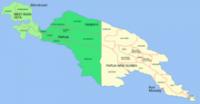|
|
|
New Guinea is differentiated from its drier, flatter, and less fertile southern counterpart, Australia, by its much higher rainfall and its active volcanic geology, with its highest point, Puncak Jaya, reaching an elevation of 4,884 m (16,023 ft). Yet the two land masses share a similar animal fauna, with marsupials, including wallabies and possums, and the egg-laying monotreme, the spiny anteater, or echidna. Other than bats and some two dozen indigenous rodent genera, there are no pre-human indigenous placental mammals. Pigs, several additional species of rats, and the ancestor of the New Guinea Singing Dog were introduced with human colonization. The human presence on the island dates back at least 40,000 years to the oldest human migrations out of Africa. Research indicates that the highlands were an early and independent center of agriculture, with evidence of irrigation going back at least 10,000 years. Given the time depth of its inhabitation and its highly fractured landscape, an unusually high number of languages are spoken on the island, with some 1,000 tongues (a figure higher than that of most continents) having been catalogued out of an estimated world-wide pre-Columbian total of 6,000 human dialects. Most are classified as Papuan languages, a generally accepted geographical term which a minority of authors hold to be a genetic one. A number of Austronesian languages are spoken on the coast and on offshore islands. In the 16th century Spanish explorers discovered the island and called it Nueva Guinea. In recent history western New Guinea was included in the Dutch East Indies colony. The Germans annexed the northern coast of the eastern half of the island as German New Guinea in their pre � World War I effort to establish themselves as a colonial power. Following the Treaty of Versailles, the German portion was awarded to Australia (which had already claimed the southeast, named the Territory of Papua) as a League of Nations mandate. The eastern half of the island was granted independence from Australia as Papua New Guinea in 1975. The western half gained independence from the Dutch in 1961, but became part of Indonesia soon afterwards in controversial circumstances. |




 RSS
RSS